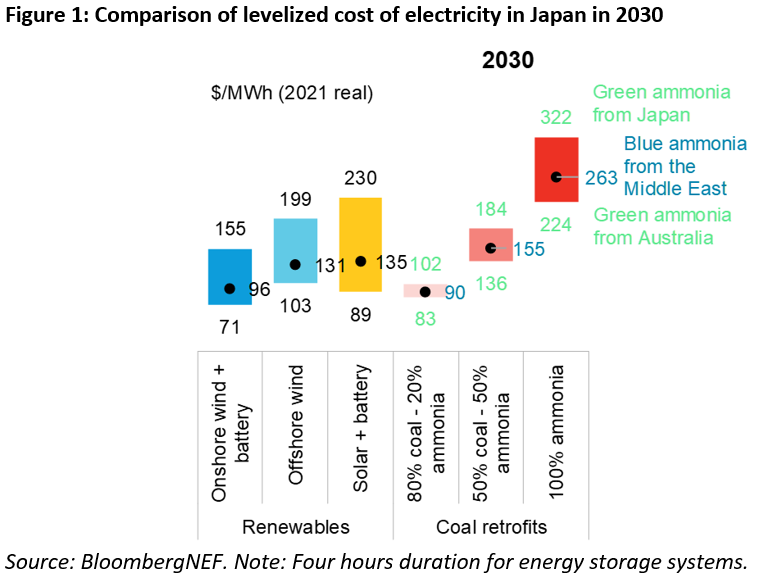PRESS RELEASE
Japan’s Ammonia-Coal Co-Firing Strategy a Costly Approach to Decarbonization, Renewables Present More Economic Alternative
Clean ammonia is better suited for the decarbonization of other applications such as fertilizer production
Tokyo, September 28, 2022 – Japanese utilities are exploring the case for retrofitting their existing coal power plants to enable co-firing of coal with ammonia to reduce carbon dioxide emissions. However, ammonia-coal co-firing is unlikely to become an economically viable path for Japan to reduce power sector emissions, according to a new report published by research firm BloombergNEF (BNEF).
BNEF estimates the levelized cost of electricity (LCOE) for a retrofitted coal power plant in Japan using a 50% clean ammonia co-firing ratio would be at least $136 per megawatt-hour (MWh) in 2030. By 2050, the LCOE of a retrofitted coal power plant running 100% on clean ammonia is expected to be at least $168/MWh. These values are more expensive than the LCOE of renewable alternatives such as offshore wind, onshore wind or solar with co-located batteries.

Ammonia co-firing technology would require a significant rise in Japan’s carbon tax to make the technology economically viable. BNEF’s analysis shows that at least $300 per ton of CO2 would be needed to make clean ammonia co-firing at a 20% blend rate economically viable in 2030. By 2050, the carbon price needed to make 100% ammonia-fueled retrofitted coal plants economically viable could be reduced to around $159/ton of CO2. These values are far higher than Japan’s current “tax for climate change mitigation” set at below $3/ton of CO2.
“Retrofitting coal plants to burn ammonia is too expensive, especially with a high co-firing ratio. Japan would be better served accelerating the deployment of renewable energy to decarbonize its power sector,” said Isshu Kikuma, Japan analyst at BNEF and lead author of the report. “Coal power generation is currently used to provide baseload power, but this should not be the case for ammonia co-firing technology given its poor economics.”
Reduction in CO2 emissions is the main advantage of ammonia co-firing at coal power plants. But burning ammonia can lead to emissions of other greenhouse gases such as nitrous oxide. Since ammonia molecules include nitrogen, ammonia combustion generates nitrous oxide, whose global warming potential (GWP) is 273 times larger than that of CO2 for a 100-year timescale. BNEF’s analysis also found that a coal power plant retrofitted to co-fire ammonia at 50% or lower blend rates still emits more CO2 than a natural gas fueled combined cycle gas turbine power plant.
Scaling coal retrofits with ammonia would also risk Japan’s energy security due to the high domestic cost of clean ammonia production, and the high volume of ammonia that retrofitted coal plants would require. The Japanese government’s proposed 2050 ammonia demand target is thirty times the current domestic ammonia market.
Kikuma said: “Japan is better off in prioritizing the limited supply of high-cost clean ammonia for decarbonization of applications such as fertilizer production where no other decarbonization options exist.”
The full Japan’s Costly Ammonia Coal Co-Firing Strategy report is publicly available in both English and Japanese.
Contact
Veronika Henze
BloombergNEF
+1-646-324-1596
vhenze@bloomberg.net
About Bloomberg on Climate
Led by Michael R. Bloomberg, a global climate champion and Special Envoy to the UN Secretary-General on Climate Ambition and Solutions, Bloomberg Philanthropies and Bloomberg L.P. are tackling the climate crisis from every angle. Bloomberg Philanthropies is at the forefront of U.S. and global efforts to fight climate change and protect the environment, bringing together mayors and other government and business leaders, grassroots partners, and environmental advocates across a key array of issues. These philanthropic efforts are accelerating the transition from coal to clean energy, improving air quality and public health, advancing city and local climate action, protecting and preserving ocean ecosystems, and helping unlock billions of dollars in sustainable finance. At the same time, Bloomberg L.P. is providing the global financial community with data-driven insights, news, and analysis to help integrate an ESG lens across the investment process. As a company, Bloomberg L.P. is also leading by example, including committing to 100% renewable energy by 2025 and taking action in the communities where its employees live and work. And through Bloomberg’s stewardship of the Glasgow Financial Alliance for Net Zero and the Task Force on Climate-related Financial Disclosures, Bloomberg is using the power of the capital markets to address climate change and support the transition to a net-zero economy.






